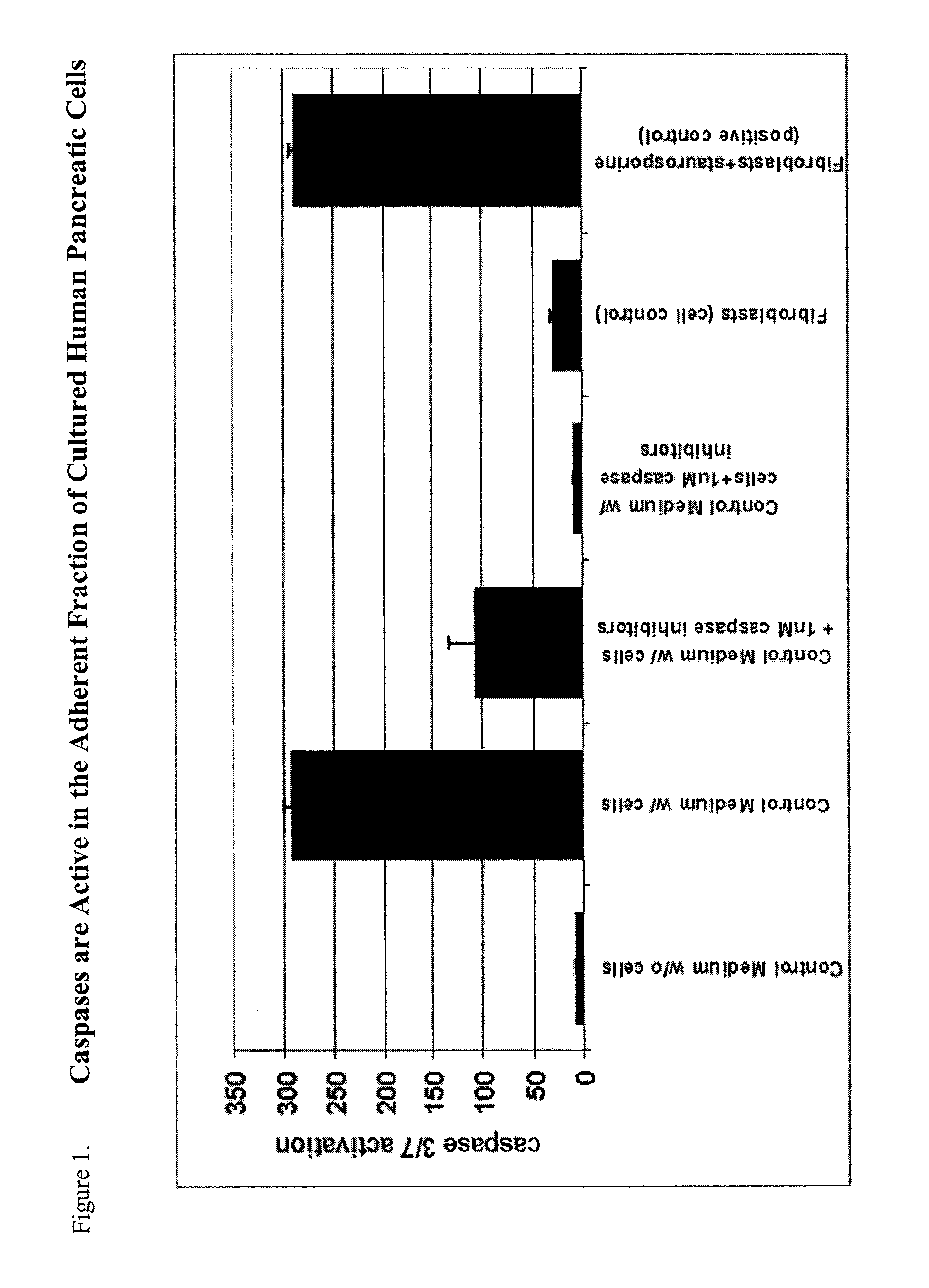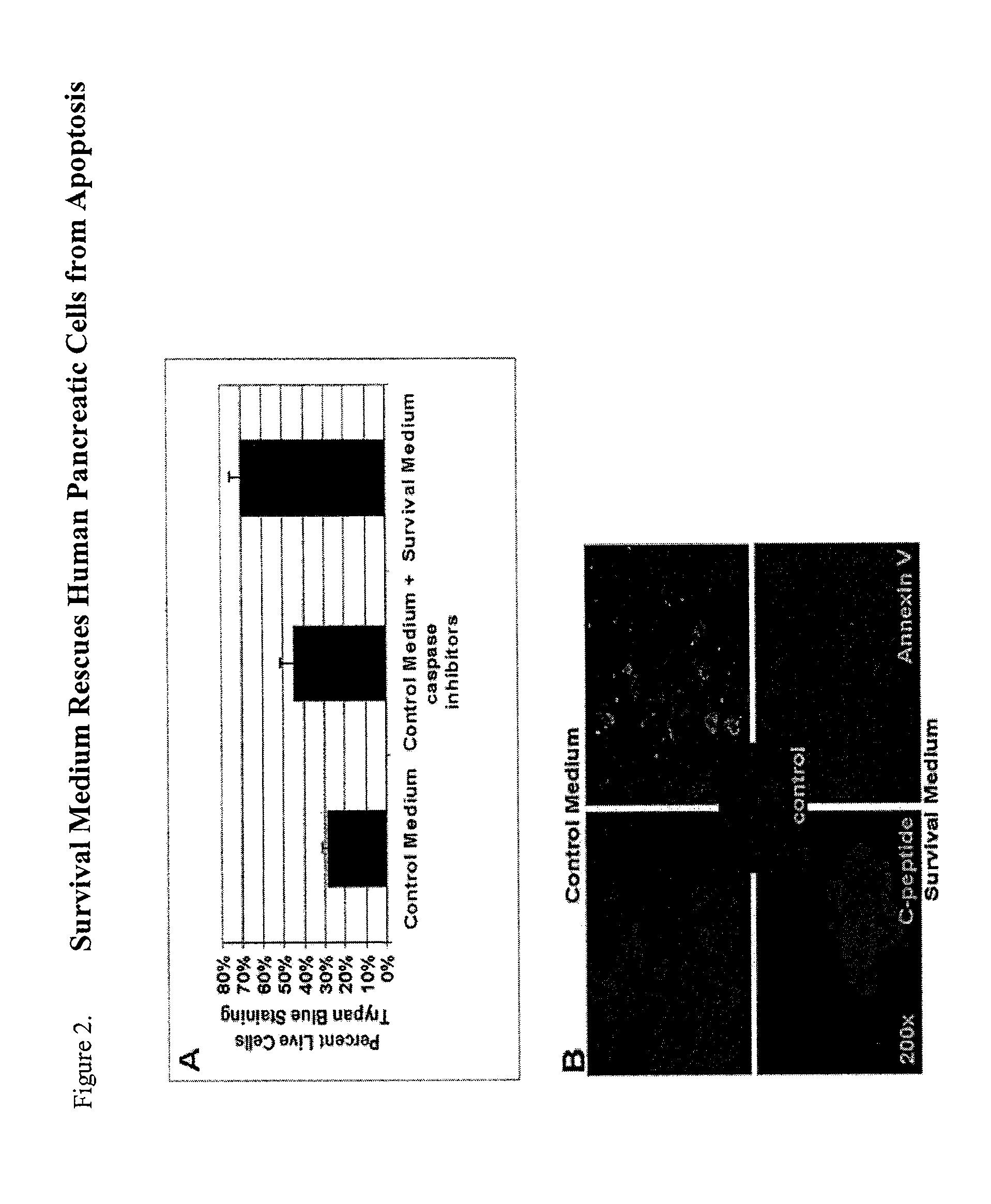Method of improving cell proliferation of pancreatic progenitor cells in a pancreatic cell culture
a cell culture and pancreatic technology, applied in the field of improving the cell proliferation of pancreatic progenitor cells in a pancreatic cell culture, can solve the problems of limiting the effectiveness of a treatment procedure, multiple damaging insults, loss of function of grafts, etc., to improve the level of activated akt, improve the level and reduce the apoptosis of pancreatic endocrine cells
- Summary
- Abstract
- Description
- Claims
- Application Information
AI Technical Summary
Benefits of technology
Problems solved by technology
Method used
Image
Examples
example 1
Pancreatic Endocrine Cell Culture
A. Organ Procurement
[0109]Pancreatic cells are isolated from cadaver pancreases. Organ harvesting is orchestrated by United Network for Organ Sharing (“UNOS”) and local organ donor organizations. Only donors with signed consent forms for research are used.
[0110]For harvesting the pancreas, the abdominal aorta is cannulated below the junction of the renal artery, and the portal perfusion is cannulated via the inferior mesentery vein. The cannula is inserted into the portal vein (PV) to the level above the junction of the splenic vein (SV) to the PV. A loose 2-0 tie is put around the SV at the junction with the portal vein, and another loose 2-0 tie is put around the splenic artery (SA). The SV tie is ligated and cut open on the spleen side immediately before the perfusion starts. This makes the pancreas perfusion more efficient without aortic / portal double end pressure which may damage the islets. It also allows all the portal perfusant to go into the...
example 2
Proliferation of Pancreatic Endocrine Cells Grown in Survival Media
A. Counting of Viable Cells Using Trypan Blue
[0119]To assess proliferation and survival of pancreatic endocrine cells cultured in survival media compared to culture in control media, cell numbers and proliferation were assessed during the different stages of the culture process. Upon reaching 90% confluence, a single pancreatic cell suspension was generated using 0.05% trypsin. Using trypan blue for viability assessment, viable cells were counted using a hematocytometer. Results indicated an increased number of viable cells in cultures treated with survival media as compared to cultures treated with control media.
B. Immunolabeling with Antibodies Against the Cell Proliferation Marker, Ki-67
[0120]Pancreatic endocrine cells grown and expanded in survival media proliferate and survive at a greater rate than pancreatic endocrine cells grown and expanded in control media. To confirm this, cells were grown in 4-well chamb...
example 3
Detection of Apoptosis and Active Caspases in Pancreatic and Fibroblast Cell Cultures
A. Apoptosis in Pancreatic and Fibroblast Cell Cultures.
[0122]One of the earliest indications of apoptosis is the translocation of the membrane phospholipid phosphatidylserine (PS) from the inner to the outer leaflet of the plasma membrane. Once PS is exposed to the extracellular environment, its binding sites become available for Annexin V, a 35-36 kDa, Ca 2+-dependent, phospholipid binding protein with a high affinity for PS. For determination of cells undergoing early apoptosis, P0 pancreatic cells, or normal cycling human fibroblasts, were plated on 4-well chamber slides and grown under conditions described herein. Prior to being passaged, the cells were incubated with a fluorescent conjugate of Annexing V, annexin-V-EGFP, in 500 ml μl binding Buffer for 5 minutes per the manufacturer's instructions (U.S. Biological, Swampscott, Mass.). The apoptotic cells were visualized and counted utilizing ...
PUM
 Login to View More
Login to View More Abstract
Description
Claims
Application Information
 Login to View More
Login to View More - R&D
- Intellectual Property
- Life Sciences
- Materials
- Tech Scout
- Unparalleled Data Quality
- Higher Quality Content
- 60% Fewer Hallucinations
Browse by: Latest US Patents, China's latest patents, Technical Efficacy Thesaurus, Application Domain, Technology Topic, Popular Technical Reports.
© 2025 PatSnap. All rights reserved.Legal|Privacy policy|Modern Slavery Act Transparency Statement|Sitemap|About US| Contact US: help@patsnap.com



